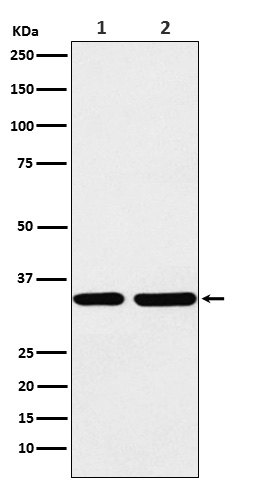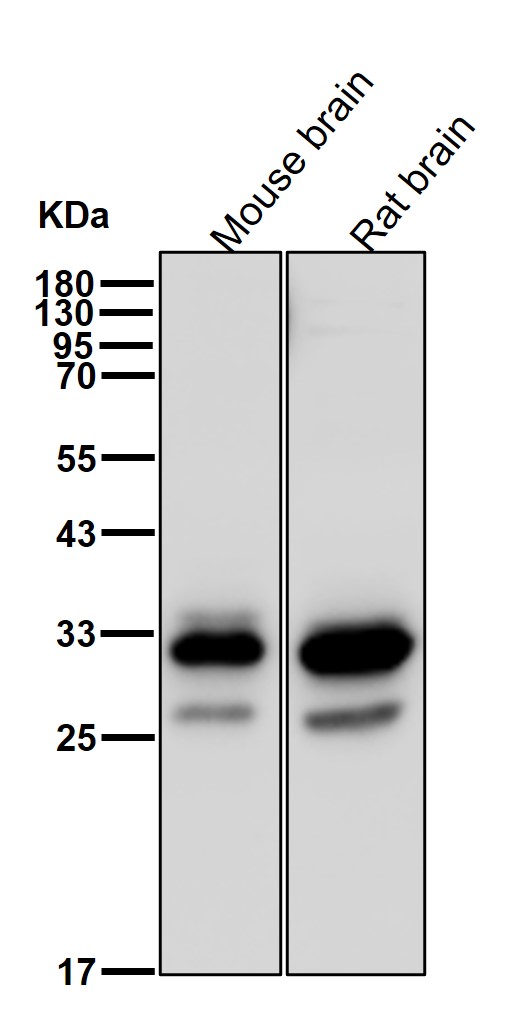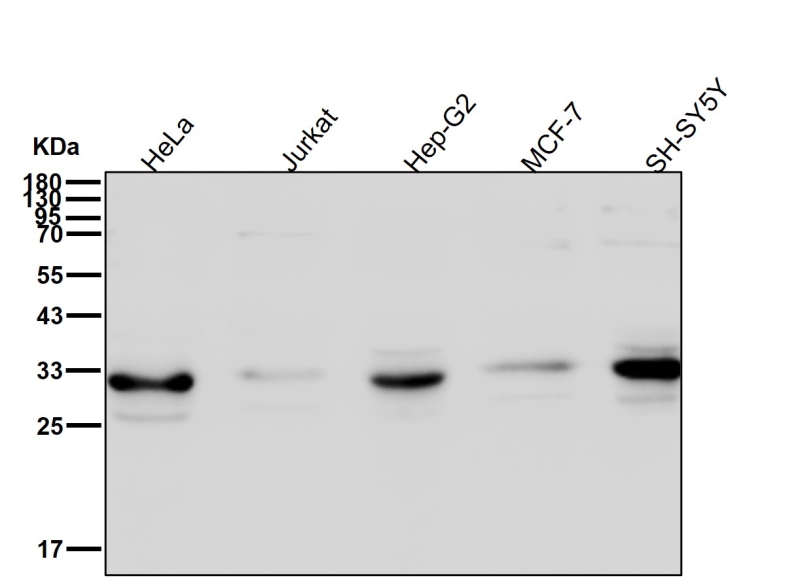


| WB | 1/1000-1/2000 | Human,Mouse,Rat |
| IF | 1/20-1/50 | Human,Mouse,Rat |
| IHC | 咨询技术 | Human,Mouse,Rat |
| ICC | 1/50-1/200 | Human,Mouse,Rat |
| FCM | 1/20-1/100 | Human,Mouse,Rat |
| Elisa | 咨询技术 | Human,Mouse,Rat |
| Aliases | STUB1; CHIP; HSPABP2; NY-CO-7; SDCCAG7; UBOX1;;STUB1 |
| WB Predicted band size | 35 kDa |
| Host/Isotype | Rabbit IgG |
| Antibody Type | Primary antibody |
| Storage | Store at 4°C short term. Aliquot and store at -20°C long term. Avoid freeze/thaw cycles. |
| Species Reactivity | Human,Mouse,Rat |
| Immunogen | A synthesized peptide derived from human STUB1 |
| Formulation | Purified antibody in PBS with 0.05% sodium azide,0.05% BSA and 50% glycerol. |
+ +
以下是关于STUB1抗体的3篇示例文献(内容为示例性概括,建议通过学术数据库核实具体信息):
---
1. **文献名称**: *STUB1 regulates proteasome-dependent degradation of misfolded proteins*
**作者**: Zhang Y, et al.
**摘要**: 研究利用STUB1抗体(Western blot及免疫共沉淀)揭示STUB1通过泛素化标记错误折叠蛋白,促进其经蛋白酶体降解的分子机制,为神经退行性疾病治疗提供新靶点。
2. **文献名称**: *STUB1 mutations in autosomal-recessive spinocerebellar ataxia*
**作者**: Shi CH, et al.
**摘要**: 通过免疫组化(STUB1抗体)发现STUB1基因突变导致小脑神经元中异常蛋白聚集,阐明了其在常染色体隐性遗传性脊髓小脑共济失调(SCAR16)中的致病作用。
3. **文献名称**: *STUB1-HSP70 complex mediates tau degradation in Alzheimer's disease models*
**作者**: Joshi S, et al.
**摘要**: 利用STUB1抗体和敲除模型证实STUB1与HSP70协同作用,促进阿尔茨海默病中tau蛋白的泛素化降解,为靶向STUB1的疗法提供实验依据。
---
**注**:以上文献信息为示例性总结,实际研究中需通过PubMed或Google Scholar检索关键词“STUB1 antibody”或“CHIP antibody”获取具体文献。
The STUB1 antibody targets the STUB1 protein, also known as CHIP (C-terminus of HSC70-interacting protein), a critical player in cellular protein quality control. Encoded by the *STUB1* gene, CHIP functions as an E3 ubiquitin ligase and co-chaperone, collaborating with heat shock proteins (HSP70/HSP90) to tag misfolded or damaged proteins with ubiquitin for proteasomal degradation. Structurally, it contains a tetratricopeptide repeat (TPR) domain for chaperone binding and a U-box domain for E3 ligase activity. STUB1 also modulates stress-response pathways (e.g., HSF1 activation) and regulates signaling cascades like NF-κB, influencing apoptosis, inflammation, and metabolism.
Antibodies against STUB1 are essential tools in techniques such as Western blotting, immunoprecipitation, and immunofluorescence to study its expression, localization, and interactions. These antibodies help investigate STUB1's roles in diseases linked to protein misfolding, including neurodegenerative disorders (Alzheimer’s, Parkinson’s, spinocerebellar ataxias), cancer (where it may act as a tumor suppressor or promoter), and metabolic syndromes. Mutations in *STUB1* are associated with autosomal recessive spinocerebellar ataxia type 16 (SCAR16), highlighting its importance in neuronal health.
Validating STUB1 antibodies requires specificity checks (e.g., using knockout cell lines) to avoid cross-reactivity with homologous proteins. Research applications span elucidating proteostasis mechanisms, exploring disease pathology, and identifying therapeutic targets.
×